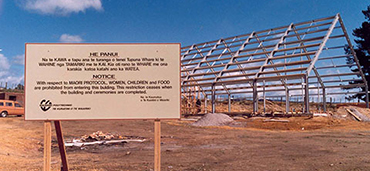Tangatarua Marae Whakapapa/History
The concept of a marae complex to be established on the Mokoia Campus at Waiariki Institute of Technology – Whare Takiūra was first mooted by Māori students studying at Waiariki in 1987.
Their thoughts were expressed to the late Mr Tom Rēweti, the first Head of Te Kura Māori. Tom had already nurtured similar thoughts and set about creating a vision for such a complex. Once given time to ponder and deliberate over this vision, the Chief Executive at the time, Mr Malcolm Murchie, endorsed it.

Tangatarua Marae History
In 1991, the Chief Executive, Mr Arapeta Tahana, and Kaumātua, Dr Te Hiko-o-te-rangi Hohepa, picked up on the vision, and a year later it began to materialise with a project plan set in place.
A ground breaking ceremony using ancient karakia (prayer) and rituals took place on the land where the marae was to be situated. The ceremony would allow the site to be cleared of the fully grown blue gum trees. The karakia themselves were to acknowledge the god of the forest Tāne-mahuta, and to apologise for the removal of some of his children, the huge blue gum trees, that were to be felled and removed.
A second ceremony, the recitation of whakapapa (geneaology) and the insertion of a carved mānuka stake into the foundations of the tupuna whare (ancestral meeting house) beneath the Paepae Poto a Houmaitawhiti (sacred beam) between the whatitoka (entrance to the tupuna whare) and the Pou Hurirōpa a Houmaitawhiti (corner to the left as you enter the tupuna whare). The stake is a symbol of the Mauri (life force) and Tapu (sacredness) being placed upon the tupuna whare. On opening day, that sacredness was lifted, and so the tupuna whare was free to be used, and to be enjoyed by all.
Tangatarua is the name of the Marae, Tangatarua being an ancestor of the Tūhourangi/Ngāti Wāhiao tribe. He was a peacemaker in his time, and lived on the land where the Mokoia Campus is situated today.
Ihenga is the name of the tupuna whare, an ancestor who came on the Te Arawa Canoe. He, too, was a peacemaker and an intrepid explorer, naming most of the place names around the Rotorua area, including the mountains, rivers, and lakes. Te Kura Māori tutors, Lyonel Grant and Tina Wirihana, were master carver and master weaver, respectively. Art tutors George Andrews and Debbie Thyne were responsible for the artwork throughout the tupuna whare with George Andrews and art students taking the lead for the ceramic designs. It took three years to complete the carvings and weavings of Ihenga, and on the 5th of October 1996, before sunrise, the karakia hiki i te tapu (the lifting of everything sacred) began. And so, Tangatarua Marae was officially opened.
Rāwiri Te Whare was the co-ordinator and Master of Ceremonies for the opening, and ensured that all areas were covered and coordinated to a successful conclusion.
